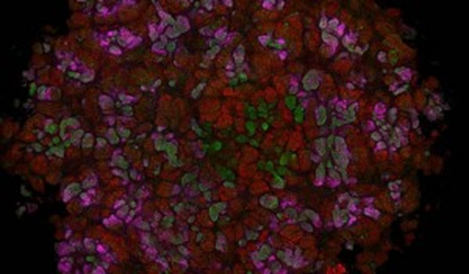Internal Medicine, Nephrology
To this purpose Research at Nephrology is divided into four main themes:
1, Regenerative medicine
2, Renal immunology and transplantation
3, Vascular nephrology.
4. eHealth and Value based Health Care
Within these themes a variety of proje
Theme 1: iPSC derived kidney organoids
Our research ultimately strives to overcome the shortage of human donor organs by using pluripotent stem cells for kidney bioengineering.
Human induced pluripotent stem cells (hiPSCs) are derived in the laboratory by reprogramming somatic cells. These can self-replicate indefinitely in culture and differentiate to all cells of the human body, including kidney cells. We make use of a unique culture protocol to differentiate these cells to intermediate mesoderm that subsequently further specializes to form kidney organoids that contain complete nephrons. These nephrons include all cap mesenchyme derived elements such as podocytes, proximal and distal tubular segments, stromal cells and endothelium. Furthermore, scanning and transmission electron microscopy analysis shows the presence of foot processes in the glomerular structures and characteristic microvilli and mitochondria in the tubular structures that have an open lumen.
…Our research ultimately strives to overcome the shortage of human donor organs by using pluripotent stem cells for kidney bioengineering.
Human induced pluripotent stem cells (hiPSCs) are derived in the laboratory by reprogramming somatic cells. These can self-replicate indefinitely in culture and differentiate to all cells of the human body, including kidney cells. We make use of a unique culture protocol to differentiate these cells to intermediate mesoderm that subsequently further specializes to form kidney organoids that contain complete nephrons. These nephrons include all cap mesenchyme derived elements such as podocytes, proximal and distal tubular segments, stromal cells and endothelium. Furthermore, scanning and transmission electron microscopy analysis shows the presence of foot processes in the glomerular structures and characteristic microvilli and mitochondria in the tubular structures that have an open lumen.
Our studies show that transplantation of these nephron structures results in vascularization and maturation of these tissues and glomerular structures even start to filtrate the blood and show size size-selective glomerular sieving.
To move forward in clinical application of these kidney organoids in patients, our research focuses on the their vascularization, the expansion of these tissues in size and immune-evasive strategies for iPSCs to prevent rejection of the tissues.